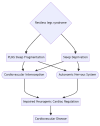Heart Rate Variability and Interoception in Periodic Limb Movements in Sleep: Interference with Psychiatric Disorders?
- PMID: 39458079
- PMCID: PMC11508612
- DOI: 10.3390/jcm13206129
Heart Rate Variability and Interoception in Periodic Limb Movements in Sleep: Interference with Psychiatric Disorders?
Abstract
Periodic limb movements in sleep (PLMS) are a prevalent disorder characterized by rhythmic, involuntary movements of the lower limbs, such as dorsiflexion of the ankle and extension of the big toe, occurring in periodic intervals during sleep. These movements are often linked to disrupted autonomic nervous system (ANS) activity and altered interoception. Interoception involves perceiving internal bodily states, like heartbeat, breathing, hunger, and temperature, and plays a crucial role in maintaining homeostasis and the mind-body connection. This review explores the complex relationships between PLMS, heart rate variability (HRV), ANS dysregulation, and their impact on psychiatric disorders. By synthesizing the existing literature, it provides insights into how ANS dysregulation and altered interoceptive processes, alongside PLMS, contribute to psychiatric conditions. The review highlights the potential for integrated diagnostic and therapeutic approaches and presents a cause-and-effect model illustrating the mutual influence of psychiatric disorders, ANS dysregulation, PLMS, and interoception.
Keywords: autonomic nervous system; cardiovascular interoception; heart rate variability; periodic limb movements in sleep; psychiatric disorders.
Conflict of interest statement
Markku Partinen reports other from Bioprojet, other from Takeda, other from Idorsia, other from Umecrine, personal fees and other from Orion-Pharma, outside the submitted work. The other authors declare no conflicts of interest.
Figures


References
-
- Bogusławski W., Solarz-Bogusławska J. Heart rate variability. Med. Rodz. 2017;20:265–272. doi: 10.25121/MR.2017.20.4.265. - DOI
Publication types
Grants and funding
LinkOut - more resources
Full Text Sources

